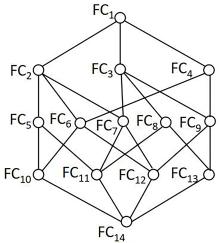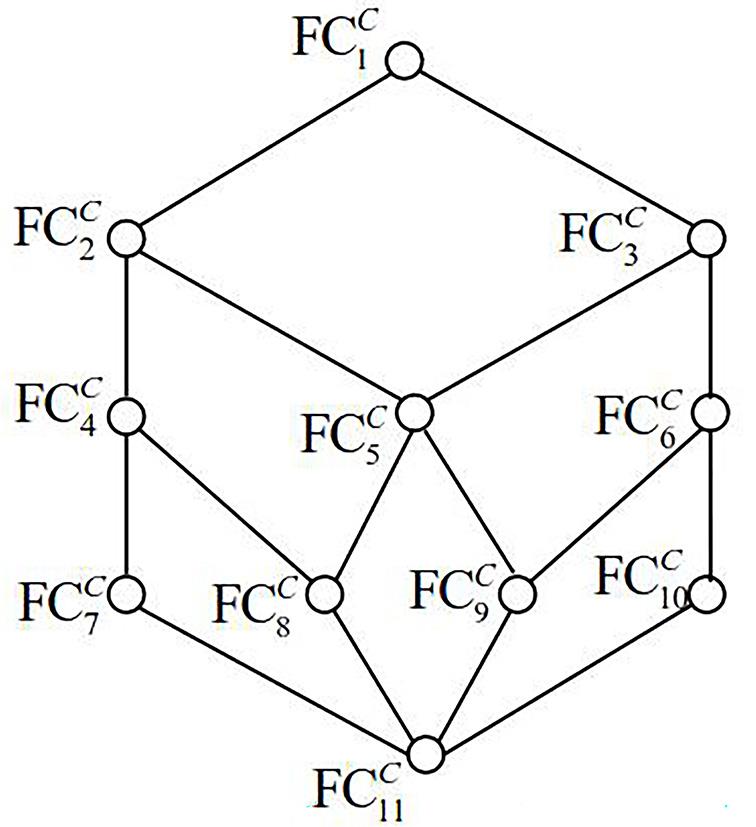南京大学学报(自然科学版) ›› 2022, Vol. 58 ›› Issue (1): 38–48.doi: 10.13232/j.cnki.jnju.2022.01.005
形式模糊背景中单边模糊概念格的属性约简
李同军1,2( ), 张晓雨1, 吴伟志1,2, 谭安辉1,2
), 张晓雨1, 吴伟志1,2, 谭安辉1,2
- 1.浙江海洋大学信息工程学院, 舟山, 316022
2.浙江省海洋大数据挖掘与应用重点实验室, 浙江海洋大学信息工程学院, 舟山, 316022
Attribute reduction of single⁃sided fuzzy concept lattice in formal fuzzy contexts
Tongjun Li1,2( ), Xiaoyu Zhang1, Weizhi Wu1,2, Anhui Tan1,2
), Xiaoyu Zhang1, Weizhi Wu1,2, Anhui Tan1,2
- 1.School of Information Engineering,Zhejiang Ocean University,Zhoushan,316022,China
2.Key Laboratory of Oceanographic Big Data Mining & Application of Zhejiang Province,School of Information Engineering,Zhejiang Ocean University,Zhoushan,316022,China
摘要:
形式概念分析是一种有效的知识表示和知识发现的方法,形式背景和形式概念是形式概念分析中的两个基本概念.形式背景描述了对象集和属性集间的一个二元经典关系,隐含其中的知识通过概念格的形式表示出来.形式模糊背景是形式背景在模糊集理论下的自然推广,建立在其上的模糊概念格在实际应用中面临许多困难,为此,多种形式的模糊概念格的改进形式应运而生.单边模糊概念格就是一种具有较好应用前景的改进模糊概念格.主要研究基于经典?模糊概念格的形式模糊背景的属性约简问题,这里属性约简的概念具有保持相应的概念格整体结构不变的含义.关于属性约简,给出了多种形式的属性约简判定定理,针对属性约简,将所有属性分为三类,探究了不同类型属性的特征刻画.最后,通过引入模糊概念间的辨识属性集的概念,得到了基于辨识属性矩阵的属性约简方法,并通过示例验证了属性约简方法的可行性.
中图分类号:
- TP18
| 1 | Ganter B,Wille R. Formal concept analysis:Mathematical foundations. Springer Berlin Heidelberg,1999. |
| 2 | Wille R. Restructuring lattice theory:An approach based on hierarchies of concepts∥Rival I. Ordered sets. Springer Berlin Heidelberg,1982:445-470. |
| 3 | 邹丽,冯凯华,刘新. 语言值直觉模糊概念格及其应用. 计算机研究与发展,2018,55(8):1726-1734. |
| Zou L,Feng K H,Liu X. Linguistic?valued intuitionistic fuzzy concept lattice and its application. Journal of Computer Research and Development,2018,55(8):1726-1734. | |
| 4 | Formica A. Semantic web search based on rough sets and fuzzy formal concept analysis. Knowledge?Based Systems,2012(26):40-47. |
| 5 | Li J H,Mei C L,Wang J H,et al. Rule?preserved object compression in formal decision contexts using concept lattices. Knowledge?Based Systems,2014(71):435-445. |
| 6 | Dias S M,Vieira N J. Concept lattices reduction:definition,analysis and classification. Expert Systems with Applications,2015,42(20):7084-7097. |
| 7 | 李美争,李磊军,米据生,等. 概念格中基于粗糙熵的属性约简方法. 计算机科学,2018,45(1):84-89. |
| Li M Z,Li L J,Mi J S,et al. Rough entropy based algorithm for attribute reduction in concept lattice. Computer Science,2018,45(1):84-89. | |
| 8 | 张文修,魏玲,祁建军. 概念格的属性约简理论与方法. 中国科学:E辑,信息科学,2005,35(6):628-639. |
| Zhang W X,Wei L,Qi J J. Attribute reduction theory and approach to concept lattice. Science in China Series E:Information Sciences,2005,48(6):713-726. | |
| 9 | Wu W Z,Leung Y,Mi J S. Granular computing and knowledge reduction in formal contexts. IEEE Transactions on Knowledge and Data Engineering,2009,21(10):1461-1474. |
| 10 | Kumar C A,Dias S M,Vieira N J. Knowledge reduction in formal contexts using non?negative matrix factorization. Mathematics and Computers in Simulation,2015(109):46-63. |
| 11 | Liu M,Shao M W,Zhang W X,et al. Reduction method for concept lattices based on rough set theory and its application. Computers & Mathematics with Applications,2007,53(9):1390-1410. |
| 12 | Li J H,Mei C L,Lv Y J. Knowledge reduction in real decision formal contexts. Information Sciences,2012,189:191-207. |
| 13 | Li J H,Mei C L,Lv Y J. Incomplete decision contexts:approximate concept construction,rule acquisition and knowledge reduction. International Journal of Approximate Reasoning,2013,54(1):149-165. |
| 14 | Burusco A,Fuentes?González R. Concept lattices defined from implication operators. Fuzzy Sets and Systems,2000,114(3):431-436. |
| 15 | Li L F. Multi?level interval?valued fuzzy concept lattices and their attribute reduction. International Journal of Machine Learning and Cybernetics,2017,8(1):45-56. |
| 16 | 张静,马建敏. 基于依赖空间的F?C变精度概念格. 山东大学学报(理学版),2021,56(1):68-74. |
| Zhang J,Ma J M. F?C variable threshold concept lattices based on dependence spaces. Journal of Shandong University (Natural Science),2021,56(1):68-74. | |
| 17 | He X L,Wei L,She Y H. L?fuzzy concept analysis for three?way decisions:Basic definitions and fuzzy inference mechanisms. International Journal of Machine Learning and Cybernetics,2018,9(11):1857-1867. |
| 18 | Kraj?i S. Cluster based ef?cient generation of fuzzy concepts. Neural Network World,2003,13(5):521-530. |
| 19 | Yahia S B,Arour K,Slimani A,et al. Discovery of compact rules in relational databases. Information Science Journal,2000,4(3):497-511. |
| 20 | Zhang W X,Ma J M,Fan S Q. Variable threshold concept lattices. Information Sciences,2007,177(22):4883-4892. |
| 21 | Shao M W,Yang H Z,Wu W Z. Knowledge reduction in formal fuzzy contexts. Knowledge?Based Systems,2015(73):265-275. |
| 22 | Shao M W,Leung Y,Wang X Z,et al. Granular reducts of formal fuzzy contexts. Knowledge?Based Systems,2016(114):156-166. |
| 23 | Li K W,Shao M W,Wu W Z. A data reduction method in formal fuzzy contexts. International Journal of Machine Learning and Cybernetics,2017,8(4):1145-1155. |
| 24 | Singh P K,Cherukuri A K,Li J H. Concepts reduction in formal concept analysis with fuzzy setting using Shannon entropy. International Journal of Machine Learning and Cybernetics,2017,8(1):179-189. |
| 25 | Mao H,Miao H R. Attribute reduction based on directed graph in formal fuzzy contexts. Journal of Intelligent & Fuzzy Systems,2018,34(6):4139-4148. |
| 26 | Shi L L,Yang H L. Object granular reduction of fuzzy formal contexts. Journal of Intelligent & Fuzzy Systems,2018,34(1):633-644. |
| 27 | Lin Y D,Li J J,Tan A H,et al. Granular matrix?based knowledge reductions of formal fuzzy contexts. International Journal of Machine Learning and Cybernetics,2020,11(3):643-656. |
| 28 | 林艺东,李进金,张呈玲. 基于矩阵的模糊?经典概念格属性约简. 模式识别与人工智能,2020,33(1):21-31. |
| Lin Y D,Li J J,Zhang C L. Attribute reductions of fuzzy?crisp concept lattices based on matrix. Pattern Recognition and Artificial Intelligence,2020,33(1):21-31. | |
| 29 | Li T J,Wu W Z. Attribute reduction in formal contexts:a covering rough set approach. Fundamenta Informaticae,2011,111(1):15-32. |
| [1] | 刘小伟, 景运革. 一种有效更新多源数据约简的增量算法[J]. 南京大学学报(自然科学版), 2021, 57(6): 1083-1091. |
| [2] | 张呈玲, 李进金, 林艺东. 基于面向对象(属性)概念格的三支规则提取[J]. 南京大学学报(自然科学版), 2021, 57(4): 599-610. |
| [3] | 高云樵,马建敏. 变精度区间集概念格[J]. 南京大学学报(自然科学版), 2020, 56(4): 437-444. |
| [4] | 刘鑫,胡军,张清华. 属性组序下基于代价敏感的约简方法[J]. 南京大学学报(自然科学版), 2020, 56(4): 469-479. |
| [5] | 程永林, 李德玉, 王素格. 基于极大相容块的邻域粗糙集模型[J]. 南京大学学报(自然科学版), 2019, 55(4): 529-536. |
| [6] | 王霞, 谭斯文, 李俊余, 吴伟志. 基于条件属性蕴含的概念格构造及简化[J]. 南京大学学报(自然科学版), 2019, 55(4): 553-563. |
| [7] | 张龙波, 李智远, 杨习贝, 王怡博. 决策代价约简求解中的交叉验证策略[J]. 南京大学学报(自然科学版), 2019, 55(4): 601-608. |
| [8] | 姚 丽1,曹仪铭2,崔 慧2,邹 丽1*. 一种基于直觉模糊语言概念格的规则提取方法[J]. 南京大学学报(自然科学版), 2018, 54(4): 758-. |
| [9] | 陶玉枝1,2,赵仕梅1,2,谭安辉1,2*. 一种基于决策表约简的集覆盖问题的近似解法[J]. 南京大学学报(自然科学版), 2018, 54(4): 821-. |
| [10] | 李俊余1,2,王 霞1,2*,刘庆凤3. 属性定向概念格的协调近似表示空间[J]. 南京大学学报(自然科学版), 2017, 53(2): 333-. |
| [11] | 李俊余1,2,王 霞1,2*. 对象定向概念格的不协调决策约简[J]. 南京大学学报(自然科学版), 2016, 52(5): 853-. |
| [12] | 施玉杰1*,杨宏志2,徐久成3. α-先验概率优势关系下的粗糙集模型研究[J]. 南京大学学报(自然科学版), 2016, 52(5): 899-. |
| [13] | 梁新彦1,2,钱宇华1,2*,郭 倩2,成红红1,2. 面向多标记学习的局部粗糙集[J]. 南京大学学报(自然科学版), 2016, 52(2): 270-. |
| [14] | 刘莹莹1,吕跃进2*. 基于相似度的集值信息系统属性约简算法基于相似度的集值信息系统属性约简算法[J]. 南京大学学报(自然科学版), 2015, 51(2): 384-389. |
| [15] | 石慧 魏玲*. 面向对象(属性)概念格的布尔表达[J]. 南京大学学报(自然科学版), 2015, 51(2): 415-420. |
|
||




